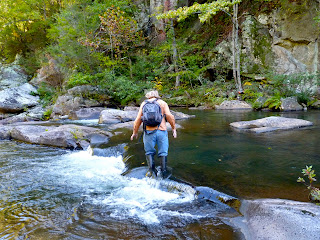Surely the most lugubrious time of year is the end of the growing season. In Atlanta, this is when pansies overtake every garden center and nursery. Row after row of little Victorian faces peer up at me, like too many orphans. Until recently I made it my policy to stride past them to where the mulch is kept.
But pansies do have qualities to be admired, one of which was demonstrated to me in the latest cold snap. While other plants blacken and die during a freeze (my long-lived begonias positively melted), pansies only experience a temporary wilt. At dawn they may look like they’ve succumbed to the cold, but by noon they are once again lifting their faces to the sun.
 |
| 9 am after a night of temperatures in the 20s. |
The secret to the pansy’s resilience is that as the temperature drops, water leaves the plant’s cells and occupies the space between (osmosis). The moisture left in the cells has a higher concentration of sugars and other molecules, raising the freezing point. What kills plants in a freeze is ice forming in the cells and rupturing the cell wall, whereas ice between the walls is safe. With little water in its cells, the pansy goes limp but lives to grow another day.
 |
| 12 pm and perking up nicely. I'll water later to aid their rehydration. |
It’s not surprising that pansies are so hardy considering that they were bred from wild violets, like the ones that pop up in yards every spring. The lawn maintenance freaks may rain down poisonous showers, but those Johnnies jump up year after year.
The Development of the Pansy
The modern pansy is a member of the viola family and began life as a pretty little weed known as heartsease (Viola tricolor) found in the fields and hedgerows of England. Two wealthy plant enthusiast and their gardeners are credited for bringing heartsease into cultivation. Lady Mary Elizabeth Bennet, with the help of gardener William Richard, began collecting and crossing heartsease. By 1813 she had a wide variety of plants to introduce to the horticultural world. At about the same time, Lord Gambier and his gardener William Thompson crossed a yellow viola (Viola lutea) and a wide-petalled pale yellow species, probably of Russian origin (Viola altaica). Soon florists and nurseries began producing hybrids so that by 1833 gardeners could choose from more than 400 named pansies. Thompson made a career of hybridizing pansies and was known in his day as “The Father of Heartsease.”
 |
| Hearstease (Viola tricolor). Photo by Jörg Hempel (2007) . |
Early pansy breeders were trying for increased sized and a round shape with overlapping petals. Wild violas like Viola tricolor have dark streaks for nectar guides. Florists developed the Show Pansy following strict guidelines as to shape, size, and color. The Fancy Pansy amateur gardeners could find easily for sale and required less rigorous tending. That dark blotch at the center of many pansies first appeared as a sport, which was cultivated in Gambier’s garden. The first pansy with a dark face was released in 1839 with the name of “Medora.”
 |
| The Development Of The Pansy Flowers (left-top to bottom-right): Wild 1830, Cultivated 1830 Show Pansy of 1870, Fancy of 1910 |
“And there is pansies. That's for thoughts.” -- Ophelia
Even before the central dark blotch was a common feature, pansies were thought of as having a face—a pensive one. The name “pansy” is derived from the French word pensée, meaning "thought." For this reason, the pansy was adopted symbol of Freethought, so that members might recognize one another by wearing the flower in their lapels. And so many nineteenth-century greeting cards feature pansies because they are shorthand for “thinking of you.”
 |
| The pansies say, "Thinking of you." The angel implies, "Even after you or I die." |
Love and its Disappointments
Pansies are also associated with love. Lady Mary Elizabeth Bennet’s collection of heartsease grew in a heart-shaped bed. Another English name for the pansy is “love in idleness,” which suggests the face of a lover whose thoughts have turned to the absent beloved.
Interestingly, Medora, the name given to the first pansy cultivar with the dark center, is also the name of Byron’s tragic heroine of The Corsair, published with great sensation in 1814. In the poem, the pirate captain Conrad departs his island hideout to do battle, leaving behind his true love, Medora. Conrad becomes entangled in saving a harem slave and dithers over murdering his enemy the Pasha. Gone so long, Medora believes Conrad dead and expires of grief. (Incidentally, Medora is also the middle name of the daughter of Byron’s lover and half sister.)
Long before the Medoras, Ophelia, in her addled state, speaks of pansies: “And there is pansies. That's for thoughts.” Her own flower she cannot give away, at least not to Hamlet, and the disappointment has unstrung her mind. Flowers have long been associated with women, with their tenderness and supposed fragility. Wounded in love they wither and die. But perhaps the pansies response to cold is the most apt comparison: a temporary wilt.
Pansies are a kind of floral Rorschach. I used to see their little parti-colored faces as a display of forced gaiety in the face of oncoming winter. But now I take a few home and plant them in a handful of pots and baskets and am grateful for their cheerful color.














































